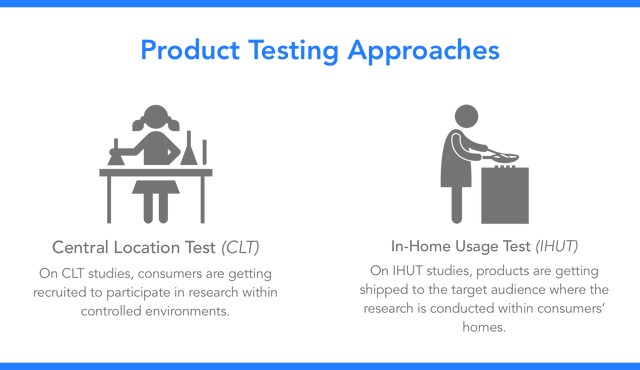In home product testing or IHUT strategy is one of the widely popular market research methods that provide valuable data about a product.
We might not think about it much but product testing is something that people do naturally and that we do all the time. We're testing products when we try a new shampoo or a new brand of milk. When we try something we've never done before like streaming music or when we try on clothes in a store or many other instances.
Now imagine all of this happening inside the comfort of your home, products are sent to people's homes and they have to record and report their impressions and thoughts about them. This is the whole idea of in-home product testing or in-home usage testing (IHUT).
What is in home usage testing (IHUT) and how it works?
IHUT (In-home Usage Testing) is a market research method where real consumers test products in their homes. It evaluates product performance, satisfaction, and usability under real-life conditions, providing brands with valuable feedback to refine and optimize before a launch. IHUTs are so beneficial because:
- we can see firsthand how a consumer interacts with the product
- We can also ask follow-up questions right then and there which makes this research methodology truly engaging.
Shortly said, in-home product testing is the process of sending products to people at home so they can provide you with data about the product.

Data gathered through at-home product testing is essential to market research, because it enables companies to fully understand the potential of their products and identify any flaws.
In conclusion, if you don't test and improve your products, at some point you're likely to lose market share either to companies that are testing their products or to new and better products coming into the market.
How to run an IHUT project?
when you want to know how to run an IHUT project, you should follow these steps:
- Identify your target audience.
- Define testing objectives and KPIs.
- Develop and distribute product samples.
- Monitor participant feedback through surveys or interviews.
- Analyze results to enhance product readiness for launch.
When developing an IHUT strategy, there are things to consider beforehand. They include but are not limited to:
- your objectives
- Number of participants
- Duration of in-home testing
- reward or motivators for participants
Product tests, typically are used to answer a variety of questions like:
- Is the product strong enough for likely success in the marketplace?
- Is it good the way it is? Or does it need improvement?
- How can the product be improved?
Read more: Definitive Guide About Product Sampling
Other things like if you are working on a new formulation or a reduced-cost formula for a product.
- How does it perform?
- How does it perform compared to the current product?
- Can consumers even tell a difference between the two?
- And if they can which one is preferred?
You can also determine how a test product or a current product can perform in comparison to its key competitors. So there are a lot of ways to use product testing. In addition, to these you can do things like, assess the performance of a product in terms of its shelf-life:
- How long does it actually last or stay fresh on the shelf?
- How easy is it to use?
- Or what is the consumers' overall experience with the product?
Moreover, you can look at various aspects of package design within the context of a product sample.
- Does it function properly?
- Is the design appealing and attractive to consumers who are using or potentially buying the product?
- And what are some reasons for a low repeat purchase rate?
If you notice that a product is on the market, but it doesn't seem to be bought as often as you would like, you can do some investigating to determine the reasons for that.
Developing an IHUT Strategy: A Step-by-Step Guide
To craft an effective IHUT strategy:
- Outline clear goals.
- Choose target demographics.
- Design feedback methods (e.g., surveys).
- Plan product delivery logistics.
- Collect and analyze data for actionable insights.

Step One: Getting your facts straight
You need to know exactly why you are running this campaign. Is this a new product? Is it an upgraded version of a current product?
Moreover, you must know what is the goal of the IHUT campaign. Do you want to know how well the new feature is understood? Is your new formula working better than your competition?
Step Two: Creating an action plan
After you have figured out the purpose of your IHUT campaign, it's important to design an action plan that includes key tasks, dates, and responsible parties.
By doing this, it is ensured that everyone continues to work on the project as planned. The project action plan must be a living document and updated throughout.
Step Three: Recruiting participants
You must determine which segment of participants would be appropriate for your product and your IHUT campaign objectives.
Keep in mind that not everyone recruited will complete the survey, so you will need to budget for more participants. This completion ratio can range anywhere between 65 and 90 percent. Phone calls, online panels, and social media can all be used to recruit.
Step Four: Creating Surveys and Evaluation forms
This is simply the most important step of the IHUT strategy development. As we discussed, during the test period, the participants complete an assessment form or survey, after using the product.
If they are only testing one product, it can be completed once, or if they are also testing competing items, it can be completed multiple times. Here are a few possible techniques:
- Classic form or diary: In some IHUT strategies, a paper form or diary is mailed along with the product to be filled after usage.
- Online survey: This method will get you immediate and real-time data from the participants through an online form they fill out.
- Email survey after the usage period: Some companies prefer to follow up with the participants by email after the IHUT period is over.
Step Five: Developing packs and mailing
The next step is to create product packs or kits that will be delivered to the participants. This process includes packing and preparing the product for testing, an introduction note with contact information, and creating a booklet with frequently asked questions, and guidelines.
Also Read:Digital Product Sampling vs. Traditional Product Sampling
One thing to bear in mind is that poorly put-together kits result in less engaged and responsive participants. Prepare your products for your IHUTs with care; it will pay off with higher response rates and higher-quality data.
Step Six: Reminders and follow-ups
Reminders and follow-up are necessary, as is the case with all market research, particularly qualitative.
Additionally, keep in mind that participants may view the IHUT strategy with mistrust given that you are going through the trouble and expenses of shipping products to their homes.
No matter how you look at it, these emotions and mindsets are destructive for IHUTs and market research in general. It is crucial to imagine yourself in their position.
It's in your best interest to have everything prepared, respond to questions before they are asked, and get in touch with responses directly. It's crucial to have a real person on the other end of the phone who can reassure the respondent.
Step Eight: Collect Surveys and forms
Recall surveys are frequently used as the last step for participants to finish their involvement in an IHUT campaign. In this step, participant testers receive an email with a recall survey.
It is also recommended to conduct a phone call follow-up in this step. This phone call might occasionally be longer and more in-depth. The number of questions and length of these memory surveys can vary. The recall surveys could inquire about:
- Favorite Things
- Ideas for improvements
- Satisfaction with the product
- Likelihood of buying
- Supplementary information
If necessary, the participant may be asked to participate in a follow-up phone call in the final question of the online survey. This gives the client the chance to follow up if additional clarity is needed.
Step Nine: Fulfillment Reward
After all the tasks and follow-ups are completed, it is important for the participants to be rewarded for their involvement in the IHUT campaign. Try to complete this task as soon as possible as delaying it might start rumors and bad word of mouth about your brand.
Step Ten: Data Analysis and Conclusion
The last and possibly the most vital step of the IHUT strategy is analyzing the gathered data and making decisions based on the conclusions.
Now you have everything to know if your product is ready for mass production and entering the market.
Recommended Techniques for In home product testing strategy
The most widely used IHUT techniques are the following research designs:
- Monadic
The Monadic method is for product testing on its own (by itself) which offers many advantages.
- Interaction between products is eliminated
- It simulates real life
- It provides the most accurate and actionable diagnostic information by focusing the respondents' attention upon one product, by focusing the respondent's attention upon one product.
- It allows the development of norms and action standards.
- Sequential monadic
Sequential Monadic Designs are frequently used to cut costs. In this research design method, each respondent reviews two products sequentially. Sequential monadic testing has some of the same benefits as pure monadic testing and generally works rather well.
However, the potential for misunderstanding and confusion between the two products exists when requesting customers to test two products in their homes, which is a significant drawback as compared to a Monadic design.
- Paired-comparison
With this approach, the participant is invited to compare two products side by side and decide which one is superior. Because of its "facial value" or "face validity," it's a great design to use when presenting evidence to a jury.
- The paired comparison is a testing method that can be quite sensitive, i.e., it can measure very small differences between two products.
- Due to the possibility of smaller sample numbers in particular circumstances, the paired-comparison test is frequently less expensive than alternative approaches.
- Its value is constrained by a genuine, continuing product testing effort.
- It does not indicate when either product is not good.
- The use of normative data is not appropriate for this test.
- The "interaction effect" (i.e., any differences in the control product would result in comparable variance in the test product's results) has a significant impact on the paired-comparison test.
- In an in-home usage test, there is a significant chance that the participant may mistake one of the two goods for the other.
- Protomonadic
This concept has many definitions according to different researchers. But it starts off as a monadic test, then moves on to a paired comparison.
- The paired comparison at the conclusion might be seen as a safety net—added assurance that the results are accurate—and the protomonadic design produces useful diagnostic data.
- Instead of in-home testing, the protomonadic design is frequently employed in central taste testing (because of the complexity of execution in the home).
Monadic research designs are recommended for IHUTs because nearly all consumer products can be tested in this method and the results are free of interaction and suppression effects.
Also Read: Rapid Product Testing Sprints Through Product Sampling
How much does an IHUT Campaign Cost?
Similar to any other kind of market research method, it is not easy to estimate a definite cost for IHUT as well. However, it is safe to say that the IHUT strategy will cost as much as you would want it to perform and generate results for you. In order to know the exact cost of in-home product testing, you will need to figure out your specific needs and preferences with the campaign.
Final words
In conclusion, the IHUT strategy will help you get an excellent feel of how your product will actually perform in the market and it will cost you as much as any other market research campaign would. It is important for companies to use product testing strategies before fully launching and entering the market. Otherwise, they are blindly walking through the dark while the competitors are holding a torch (of IHUT strategy).



